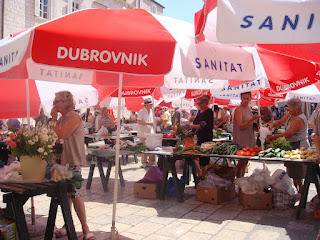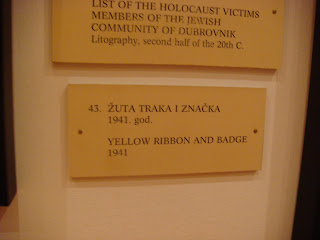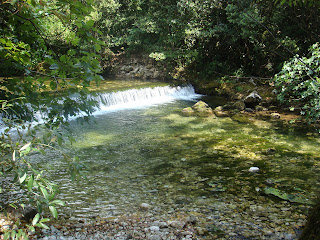The confluence of the rocky mountainous Dalmatian coastline,
scattered forested islands and the clear blue waters of the Adriatic
Mediterranean make Dubrovnik’s location hard to beat!!
Sailing into this small port provided us another memorable
experience.
The buildings of the ‘New’ city are visible from a distance
with their red tile roofs and white / cream walls; climbing from sea level up
the slopes and following the irregular coastline
By regulation, none can be taller than three stories and
roofs must be a distinctive red tile. Some are clearly very luxurious –
property here has become a hot commodity apparently purchases by wealthy
foreigners are fueling the market (Turks and Germans in particular).
We sailed by this dramatic bridge (nicknamed the Golden
Bridge by locals) constructed across the river at tremendous expense (and
shortening the drive up the coast by half an hour we were told).
Docking at the Port was somewhat of an anticlimax – we were
the only game in town at this newly constructed simple platform. It did liven
up later when a market was set up with local goods for sale.
I will have to compare photos but the buildings along the
road behind the dock look exactly like they did in the 1940s combat shots taken
by Merle’s Dad when he rocketed German shipping here!
Dubrovnik is the main port of Croatia, which has been an
independent nation again since only 1995 or so after an incredibly trying
history. It is an interesting fact that there are almost as many Croats living
outside the country (31/2 millions) as inside (4+ millions).
The Slavic peoples of the Balkans originally migrated from
the area that is now Poland and the Croatian language is still closest in its
roots to Polish. The religion they brought (Roman Catholicism) is that of over
85% of Croats while elsewhere in the area invaders have brought Eastern
Orthodox and Islam.
The origins of Dubrovnik go back to 650 AD or so when
Latin-speaking refugees of a Slav onslaught on the Roman City of Epidaurum set
up a settlement on an island they called Ragusa a short distance off the shore
where the Slavs lived.
They built fortifications and prospered through trade.
The Slavs on the mainland in the meantime had developed
their settlement , which they named Dubrovnik.
Around the 12th Century these two settlements
merged; the sea channel between the island and the mainland was filled in and
paved; and a new set of walls was constructed around the combined settlement creating
what is now the Old town of Dubrovnik.
The solidly constructed walls and well protected harbor
provided a secure base for an expanding commercial empire. The hardwood forests
provided the timber for solidly constructed ships and provided the basis for
the city’s Slavic name (Dubrovnik means well wooded).
Ragusa had no territorial aspirations and remained focused
on success in trade through its sailors and merchants and on diplomatic
neutrality through skilled statesmen. Venice (a very competitive trading
nation) held sway in the 12th and 13th centuries (from
1205 -1358) providing models for governance and statutes.
As a well-known port Ragusa had many visitors – King Richard
the Lionheart on his return from the crusades in 1192, St Francis of Assisi,
and, also presumably by ship, The Black Death (in 1348).
Uniquely in the Balkans, Ragusa managed to maintain
neutrality and thus protected markets with both the Spanish and Ottoman empires
until by 1600 it was hugely successful at a par now with Venice.
An earthquake in 1667 changed all – half the population were
killed (including almost all the Latin descendants). It only survived because
so many were away at sea during the disaster. The now predominantly Slavic city
was rebuilt from the ruins and became Dubrovnik (but never regained its former
success)
Napoleon abolished the Republic of Dubrovnik in 1808 and had
it administered as part of Dalmatia-Croatia. It was ceded to Austria at the Congress
of Vienna in 1815 and was part of the Austro-Hungarian Empire until Yugoslavia
was formed after WW I.
Yugoslavia was invaded and occupied by the Nazis in WW II.
After liberation Marshall Tito (a Croat) led Yugoslavia as a united country but
with his death that impetus fell away and the area spun out of control into
civil war, ethnic cleansings and atrocity.
Croatia was occupied and Dubrovnik heavily shelled between
1991 and 1992 after which, by treaty, a free Croatia was created – a nation
recognizable by its checker board red and white flag and its excellence in
tennis and soccer!
Our tour guide had little good to say about Serbs in
particular as a result of this painful history but also didn’t fancy Bosnia or
Montenegro particularly!
Our tour started early and was scheduled to last until ships
departure at 5.30pm so we could get a good look at the area.
Four major experiences come to mind after our short visit:
First, Old Dubrovnik.
The walled city is picturesque and seems very special despite
its rather commercial orientation (lots of repetitive tourist shops). The walls
around the town are immense and well constructed with a number of large towers
– a walk along the wall provides a wonderful view of the ocean, the harbor and
the mountains.
The original filled-in sea channel is now the main
thoroughfare – the Placa Stradum. It leads from the entry Pile gate past
Onofrios Fountain
to the old harbor.
and a small market
Narrow passageways lead off from the Placa
to the left and right.
We visited a number of the sights – first The Franciscan
Monastery, named for the Franciscan Order and more directly for the visit of St
Francis. Although badly damaged by earthquake in 1667 and shelling during the
siege of 1991 – 1992 it is remarkably intact with beautiful cloisters,
paintings and garden.
Most remarkable though is the pharmacy within its walls that
has been in constant operation since 1391. Old books, laboratory gear and relics
are displayed.
Second, we came across the Synagogue and Jewish Museum.
After the expulsion of Jews from Spain in1492 there was a wave of Sephardic
Jewish migration that passed through this
area with a small community
developing in the 16th century. By any criteria the community became
successful – in business and trade, culture and medicine. In 1546 the Jewish
community were permitted to stay within city walls and were allocated a street
with four houses – the ghetto.
Fortunes of the community waxed and waned with random
accusations and persecution that caused most to leave but a small group
persisted
In 1652 the upstairs of one of the houses was converted into
a synagogue and a cemetery was built outside the walls.
Ashkenazi Jews from the Austro Hungarian Empire moved here
in the 19th century.
The Nazis instituted their racial laws immediately after
taking power in 1941, set up camps and interned all Jews. Twenty Seven of the
87 Dubrovnik Jews were victims of the holocaust, an equal number participated
in armed resistance.
A small community persists to this day but the old synagogue
is no longer active
Third, we went for lunch to a restaurant (Konavoski Dvori)
in a lovely converted mill in the Konavle valley south of the city.
This is a favorite eating place for special occasions and
the food is considered to be excellent local cuisine.
We ate under an arbor of trees and vines with a stream of
crystal clear water running by.
Our main course was prepared by cooking lamb and veal and potatoes
for three hours in iron pots buried in coals. It was absolutely delicious and
went well with the local wine – red and white.
Fourth, we visited a beautiful seaside resort called Cavtat (pronounced ‘Tz’avtat). It was lovely to sit at a bar and drink a beer at the ocean front in the bright afternoon sunlight. This was where the Duke of Windsor and Ms Simpson spent their honeymoon apparently and is considered a very romantic location
What a lovely day!
Off we go to Italy; next stop Naples.
















































No comments:
Post a Comment